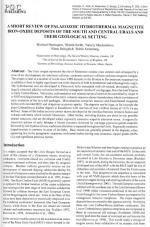Добрый день, Коллеги. Важное сообщение, просьба принять участие. Музей Ферсмана ищет помощь для реставрационных работ в помещении. Подробности по ссылке
A Short Review of Palaeozoic Hydrothermal Magnetite Iron-Oxide Deposits of the South and Central Urals, and their Geological Setting / Краткий обзор палеозойских гидротермальных магнетитовых железооксидных месторождений Южного и Центрального Урала
Краткий обзор палеозойских гидротермальных магнетитовых железооксидных месторождений Южного и Центрального Урала и их геологического положения
The Urals orogen represents the site of Palaeozoic oceanic crust creation and subsequently a zone of arc development, arc-continent collision, continent-continent collision and post-orogenic collapse. The orogen is host to a number of world-class VMS deposits in the Silurian to Devonian arc sequences but in addition is host to highly significant iron oxide deposits of both hydrothermal and orthomagmatic origin. The hydrothermal ores are developed in Palaeozoic belts associated with rift-related, dominantly mafic, largely subaerial, alkaline volcanism intruded by comagmatic stocks of varying ages, from the Late Silurian to Early Carboniferous. Volcanism, sedimentation and mineralisation all seem to be controlled by major N to NNE trending structures. Much of the mafic volcanic sequence shows hematisation, which is evidence of early oxidation of the lava-tuff packages. Mineralisation comprises massive and disseminated magnetite bodies with elevated REE and ubiquitous accessory apatite. The deposits can be huge, as for example the giant Carboniferous Kachar deposit in Kazakhstan with reserves of over a billion tonnes of >45% Fe are defined. Some of the bodies are true contact skarns developed at the interface between intrusive bodies and volcano-sediments which include limestones. Other bodies, including Kachar, are distal to any possible related intrusions and are developed within regionally extensive scapolite alteration zones. A regionally consistent pattern of early feldspar ± biotite alteration followed by ore-stage pyroxene-garnet-scapolite followed by late hydrous silicate-carbonate alteration is repeated throughout the Urals. Regionally extensive scapolitisation is common in most of the belts. Base metals are generally present in the deposits, often appearing late in the paragenetic sequence, with some bodies having near economic copper grades (0.6% Cu) and significant precious metals.




